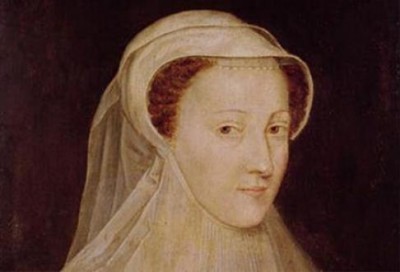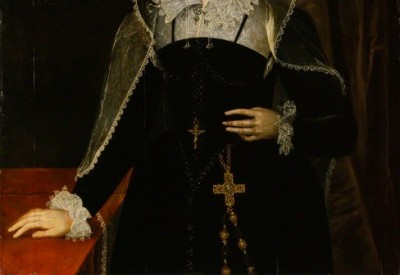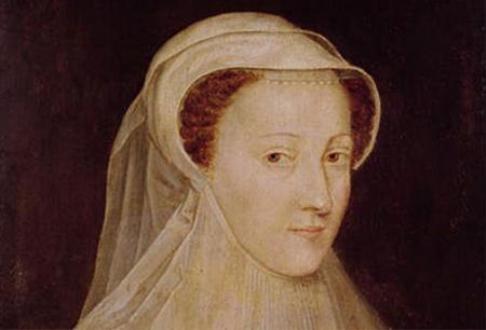I received several questions about Mary Stuart’s relationship with Elizabeth Tudor, and this article is aiming to respond to each of them and cover the hot topic of why Mary wasn’t Elizabeth’s heir.

Elizabeth I’s strained relationship dominated English and Scottish politics for many years, and one might easily question why Elizabeth didn’t recognize Mary as her successor, although she never sought to set aside her cousin’s rightful claim to the throne of England.
Under the Third Succession Act, which was passed in 1543 by the Parliament of England, Elizabeth was recognised as Mary I of England’s heir, and Henry VIII’s last will excluded the Stuarts from succeeding to the English throne.

When young Mary married the future King Francis II of France, King Henri II of France, Francis’ father, proclaimed that the young couple were King and Queen of England. Henri II also commanded that the royal arms of England be combined with the arms of Scotland and France on his niece’s badges. That was an open announcement of war to Queen Elizabeth I, who was considered by all Catholics in England and in Europe illegitimate.
William Cecil, the chief advisor of Queen Elizabeth I for most of her long reign, wrote:
“This quarrel now begun, is undoubtedly like to be a perpetual incumbrance of this kingdom.”

After Mary’s first husband, Francis II of France, unexpectedly died, the young widow was forced to return to Scotland: she lost the crown of France and was no longer welcomed there. The relationship of Mary and Elizabeth was on the edge as Mary, a threat to Elizabeth’s throne, was now too close to England.
Additionally, within a few days after her arrival, Mary sent her envoy to England, carrying a letter for her cousin, in which she asked Elizabeth to acknowledge Mary as Elizabeth’s heir. Elizabeth refused to do that, explaining that she didn’t want to nominate a successor because she believed that it would elicit disaffection of the English people towards her.
Mary tried to find a royal husband in Europe, and one of the men, whom she considered, was Don Carlos, King Philip II of Spain’s mentally unstable heir.

Still viewing Mary as a threat to her queenship, Elizabeth tried to neutralise the threat by suggesting that Robert Dudley, the Earl of Leicester, the Queen of England’s favourite and rumoured lover, might become Mary’s second husband. Mary’s attempt to enter into marriage negotiations was rebuffed by Philippe, and then she rejected Dudley, instead choosing to marry Henry Stuart, styled as Lord Darnley, her English first cousin.
Mary’s choice of her second husband wasn’t approved and liked by Elizabeth. Like Mary, Darnley was a grandchild of Margaret Tudor, Henry VIII’s sister. Darnley and Mary both had a very strong claim to the throne of England, and any descendant of them would have had even a stronger claim than their parents did.
Thus, Mary’s marriage to Darnley cemented the rivalry and the antagonistic nature of her relationship with Elizabeth – Mary became a great threat to Elizabeth and “a perpetual incumbrance” for England. I don’t think that Elizabeth could have acknowledged Mary as her heir after the Queen of Scots’ marriage to Darnley.

The passion between Mary and Darnley cooled off quite soon after their wedding, and Mary started to realize that she had made a grievous mistake.
Mary’s marriage to Darnley floundered partly, but there still was hope for them for some time because the Queen of Scots was carrying her husband’s child – the future King James V of Scotland and James I of England. However, Darnley was murdered under mysterious circumstances, and rumours about Mary’s possible involvement in her husband’s death began to spread in Scotland.

Mary Stuart made her final grave mistake – she entangled herself with James Hepburn, the Earl of Bothwell, who established emotional control over her.
Although the Earl of Bothwell was accused of Darnley’s murder, Mary didn’t want to punish him: she arranged a show trial in April 1567, where Bothwell was acquitted of all charges levelled against him by many peers of the Scottish realm. It was a turning point in Mary’s life: she didn’t know that there would be no way back to peace between her and the Scottish nobles.

Before Bothwell’s trial, Elizabeth sent Mary a letter, in which she urged her younger cousin to prosecute all those who killed her husband and to protect herself and her kingdom. Elizabeth wrote in very amicable tones:
“Madam, I treat you as my daughter, and assure you that if I had one, I could wish for her nothing better than I desire for you… the one for whom one wishes the greatest good that may be possible in this world.”
Of course, Mary didn’t listen to Elizabeth, and there is no evidence that Mary had ever responded to Elizabeth’s sympathetic letter that contained vitally important warnings for her spirited and irrational cousin.
Elizabeth showed herself even more concerned about the honour of her fellow queen when she chose to wrote Mary again in spite of Mary’s silence and ignorance of her first letter. Even though Elizabeth perceived Mary as a treat, she still cared for the younger woman enough to urge her to change her behaviour and start acting in a manner befitting a queen.

Elizabeth wrote to Mary in her own hand, in French, choosing Mary’s beloved language instead of the Scottish language. We can find in Elizabeth’s second letter to her Scottish cousin:
“For the love of God, Madame, use such sincerity and prudence in this matter [the hearing], which touches you so nearly, that all the world may feel justified in believing you innocent of so enormous a crime, which, if you were not, would be good cause for degrading you from the rank of Princess, and bringing upon you the scorn of the vulgar.”
Again, Mary didn’t respond and continued on her way to self-destruction.
In May 1567, Elizabeth heard that Mary had married the Earl of Bothwell at either Holyrood Palace or Holyrood Abbey according to Protestant rites. By marrying a man who was believed to have orchestrated Darnley’s murder Mary degraded herself as queen and smashed her reputation to pieces. It was too late to listen to Elizabeth’s warnings and, I am sure, to the warnings of some Scottish nobles who were still loyal to Mary even at that time.

Elizabeth sent Mary another letter, in which she commented on Mary’s marriage to Bothwell:
“How could a worse choice be made for your honour than in such haste to marry such a subject, who besides other and notorious lacks, public fame has charged with the murder of your late husband, besides the touching of yourself also in some part, though we trust in that behalf falsely…”
The afore-mentioned events quickly led to Mary’s complete defeat, her ultimate disgrace, and her imprisonment in Loch Leven Castle. Mary was forced to abdicate in favour of her young son James, who was separated from Mary and was taken to Stirling Castle to be raised as a Protestant.
Later, in 1568, Mary escaped from Loch Leven in 1568 and fled across the border to England, where she was immediately taken into custody by local officials. The Queen of Scots was imprisoned for the next nineteen years until her death on 8 February, 1587 at Fotheringhay Castle.

Elizabeth made many attempts to urge Mary to be more rational and prudent in choosing her course of action and her policy in Scotland, but Mary just ignored all those warnings. Years later, Elizabeth still hesitated to sign Mary’s death warrant in spite of the unrelenting pressure from Parliament and her councillors. I think that Elizabeth didn’t want to kill a sovereign monarch of another country, although Mary had already abdicated her crown.
Could Elizabeth acknowledge Mary as her heir? The answer is a categorical NO for many reasons.
Firstly, Mary was a staunch Catholic, and England wouldn’t have welcomed a Catholic queen on the throne; Elizabeth knew about that, and she didn’t want to wreak havoc in England which she loved so much. Secondly, Elizabeth didn’t want to name her heir in her lifetime just because that person would have become a threat to her, and she chose to have no threat instead of dealing with the necessity to watch her rivals on a twenty-four-hour basis. Parliament petitioned Elizabeth to name her successor, but she did not do so.

Therefore, Mary couldn’t have become Elizabeth’s heir. Instead, she was Elizabeth’s rival and a perpetual threat to the Queen of England. Mary was doomed when she escaped to England, although she didn’t understand that.





